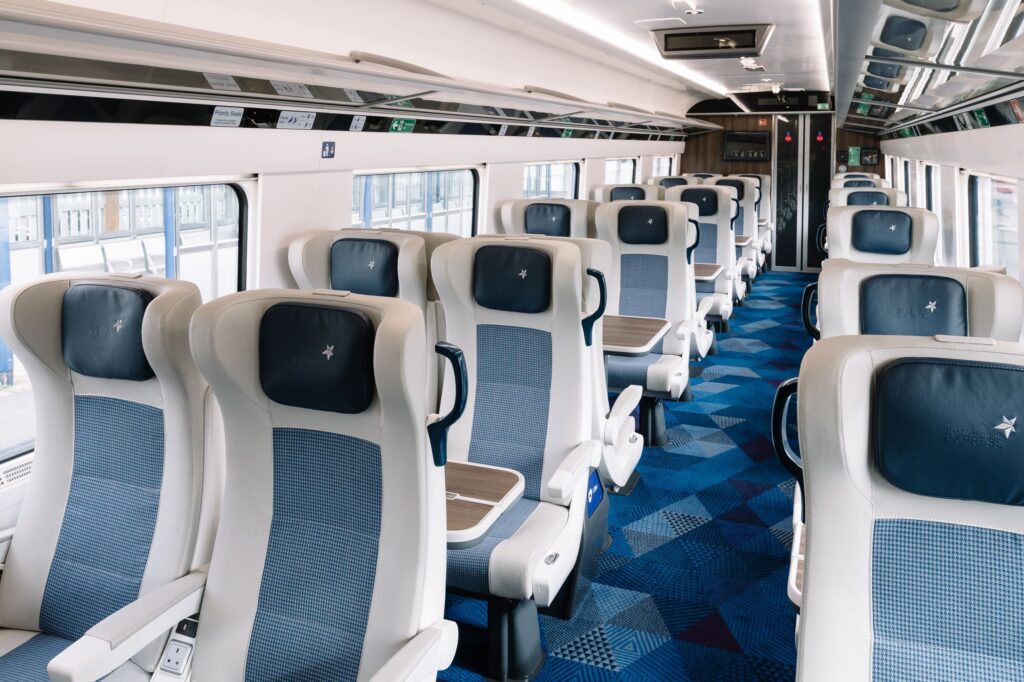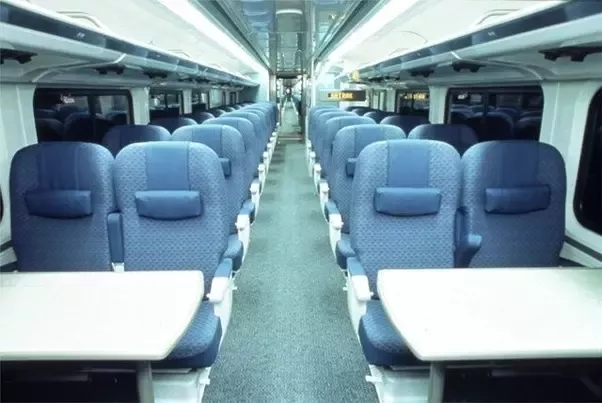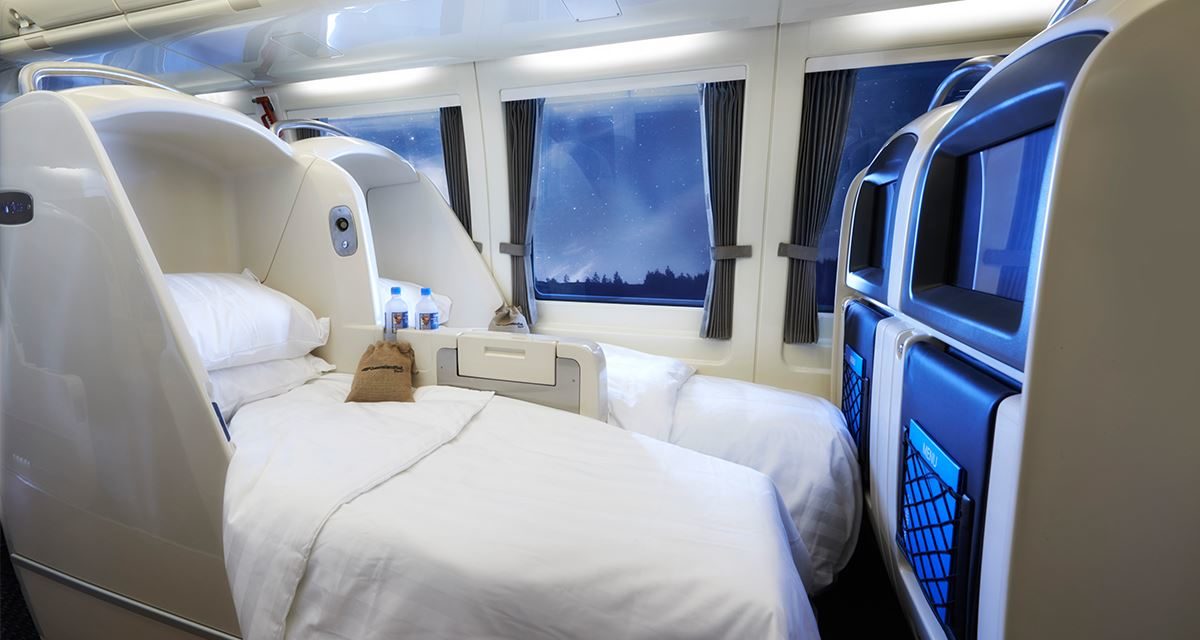You might find yourself seated across from another passenger, occasionally separated by a table. Here’s where the concept of airline-style comes into play – and no, planes aren’t part of the equation. An “Airline seat” simply refers to a seat that doesn’t feature a table in between.
In this probe, you will explore the background, the complexities of integration, the difficulties encountered, and the bright prospects ahead.
Explanation of Airline-Inspired Seating on Trains
Airline-style seating, a concept gaining traction in modern train design, embodies an arrangement that draws inspiration from aircraft interiors. This approach is tailored to optimize space usage while ensuring passengers experience a certain level of comfort during their train travel.
In addition, Much like the aviation sector, the core objective of this seating configuration is to accommodate more travelers while preserving a degree of ease and practicality.
Key Characteristics and Features:
- Seating Configuration: This style often employs rows of seats positioned in close proximity, minimizing the gap between them. The arrangement is geared towards maximizing passenger capacity without compromising on functionality.
- Comfort Considerations: While the primary focus is efficiency, seats are thoughtfully cushioned and ergonomically designed, providing basic support and a reasonable degree of comfort.
- Space Optimization: The primary aim of this approach is to utilize available space optimally, especially pertinent on routes with high demand and limited room.
Comparison to Air Travel Seating:
- Parallels: The setup closely mirrors the seating layout familiar from air travel, with its emphasis on space utilization and maximizing occupancy.
- Distinctions: While the concept is reminiscent, adaptations are made to align with train travel dynamics. Unlike airplanes, trains afford greater flexibility in seat design due to fewer regulatory constraints.
Passenger Experience:
- Convenience: The streamlined seating arrangement ensures swift boarding and disembarking, proving advantageous on routes marked by frequent stops.
- Accessibility: The layout facilitates easy movement within the train, granting passengers unobstructed access to their seats and permitting smooth passage along the aisle.
This innovative approach to train seating, inspired by principles seen in aviation, strikes a balance between accommodating a larger number of passengers and providing a certain level of practicality.
Moreover, particularly well-suited for shorter routes or those characterized by numerous stops, this design marries the efficiency of aviation with the unique demands of rail travel, offering a contemporary and functional seating solution.
Evolution and Integration of Airline-Inspired Seating on Trains

Historical Context
The origins of the airline-style seating concept date back to the need to optimize passenger capacity in confined spaces. It pioneered compact seating configurations to accommodate more travelers within limited cabin space, inspiring the development of efficient seating arrangements that eventually influenced the railway industry.
Integration into Train Travel:
Driven by motivations akin to those in aviation, the integration of airline-style seating into train travel emerged as a response to the need for maximizing occupancy without sacrificing passenger comfort. Train operators recognized the potential of this approach on high-demand routes, where swift boarding and disembarking are essential.
Moreover, the implementation of this concept is not uniform across all trains and routes. It finds its niche primarily on routes characterized by frequent stops and short distances, aligning with commuter needs and operational efficiency.
Balancing Comfort and Efficiency:
The process of integrating airline-inspired seating involves striking a careful balance between accommodating more passengers and ensuring a satisfactory level of comfort.
Also, drawing inspiration from the ergonomic principles of aircraft cabin design, designers and engineers endeavor to create seating arrangements that are both space-efficient and reasonably comfortable for passengers.
Anticipating Future Developments: As technology continues to advance, the future of airline-style seating on trains holds the promise of further innovation. Technological advancements could yield adjustable seat configurations, enhanced materials, and personalized amenities, enhancing the overall passenger experience.
Furthermore, the adaptability of airline-style seating to passenger preferences will likely drive continued refinement. Train operators can explore customization options and additional features that cater to diverse traveler needs, thus contributing to a more tailored and comfortable journey.
Envisioning the Future of Airline-Inspired Seating on Trains
Technological Innovations: Anticipate the infusion of cutting-edge technology to elevate the airline-style seating experience. Adjustable seating configurations, smart materials that offer enhanced comfort, and integrated entertainment systems could redefine the landscape of train travel, providing passengers with a seamless and personalized journey.
Enhanced Passenger Experience: The future holds the promise of tailoring airline-inspired seating to cater to individual passenger preferences. Customization options ranging from adjustable seat configurations to personalized amenities have the potential to revolutionize passenger experiences, making each journey uniquely comfortable.
Sustainability and Green Practices: As sustainability gains prominence, the integration of environmentally friendly materials and practices into airline-style seating becomes a pertinent consideration. Sustainable materials, energy-efficient features, and designs that minimize the carbon footprint could position this seating concept as a responsible choice for both operators and passengers.
Seamless Connectivity: The trajectory of travel increasingly hinges on connectivity. Future adaptations of airline-inspired seating might incorporate advanced connectivity options, allowing passengers to remain connected throughout their journey. Wi-Fi enhancements, charging facilities, and integrated tech interfaces could transform the travel experience.
Adaptation to Changing Travel Patterns: As travel trends shift, the adaptability of airline-style seating becomes crucial. Flexibility in design and arrangements will ensure that this concept remains relevant, whether on short urban routes, long intercity hauls, or routes that span various distances and passenger demands.
Cross-Mode Integration: Airline-style seating might extend beyond trains and influence other modes of transportation. Its space-efficient design could potentially find applications in buses, trams, and even short-haul flights, creating a cohesive travel experience across modes.
Catering to Evolving Demographics: With changing demographics, the needs of passengers will also evolve. Future adaptations of airline-style seating could encompass features that cater to an aging population, families with young children, or travelers with diverse mobility needs, ensuring inclusivity.
Challenges and Considerations in Implementing Airline-Inspired Seating on Trains

Gauging Passenger Feedback: Understanding passenger reactions to airline-style seating is paramount. While certain passengers appreciate the benefits of increased capacity and efficient boarding, others might express discomfort due to reduced personal space—particularly on extended journeys.
Therefore, actively soliciting and responding to passenger feedback becomes instrumental in striking the delicate balance between spatial efficiency and passenger contentment.
Prioritizing Ergonomics and Comfort: A crucial challenge revolves around upholding passenger comfort within the confines of closely arranged seats. Thoughtful ergonomic considerations are pivotal to prevent discomfort or potential health concerns arising from prolonged travel within a restricted space. The art lies in harmonizing spatial efficiency with ergonomic support to obviate passenger dissatisfaction.
Operational Adaptations: The successful introduction of this seating style necessitates operational adjustments. Designing for efficient cleaning and maintenance regimes is crucial, given the intricacies of maintaining a compact configuration. Additionally, guaranteeing safe and swift passenger movement during boarding and alighting necessitates meticulous planning and execution.
Accommodating Diverse Passenger Needs: The realm of train travel encompasses a diverse spectrum of passenger requirements—ranging from families to seniors and individuals with reduced mobility.
Additionally, crafting an inclusive environment through airline-style seating entails accommodating these multifarious needs. Solutions such as designated family spaces and accessible zones emerge as vital facets of the consideration.
Cultural and Social Sensitivities: The fabric of cultural preferences and social norms is woven diversely across regions. What proves acceptable in one cultural context might not resonate harmoniously in another.
Therefore, a nuanced understanding of cultural sensibilities is crucial when implementing a seating configuration that emulates aviation standards, facilitating adaptation to local expectations.
Balancing Budget and Quality: The financial implications of retrofitting or designing trains with airline-style seating are substantial. Striking equilibrium between budgetary constraints and the caliber of materials, comfort amenities, and overall passenger experience forms a challenge that must be adeptly surmounted.
Future-Proofing Adaptability: As the trajectory of train travel continues its evolution, the capacity to adapt airline-style seating to cater to forthcoming requirements assumes paramount importance.
Lastly, The challenge is to engineer a design that retains relevance amidst shifting travel patterns, thus ensuring that the investment in this seating configuration remains enduringly valuable.
FAQs
Which seat is best on a train ticket?
The choice of the best seat on a train depends on factors like journey duration and personal preferences. For overnight trips, the lower berth offers greater comfort. If traveling during the day, the “upper berth” or “side upper” might be preferable. Passengers seeking scenic views and interactions often opt for the “side lower” seat.
What are the different types of seating on a train?
Trains offer various seating options, including coach seats, business class seats, first-class seats, roomettes, and bedrooms, depending on the route and service. Travelers can choose between these options based on their comfort and needs.
Why are trains better than planes?
Train travel is considered more environmentally friendly than air travel. Trains emit fewer pollutants and greenhouse gases, making them a greener option. Unlike airplanes, trains have a smaller carbon footprint, making them a preferable choice for eco-conscious travelers.
What is meant by ‘airline style’ in train seats?
Airline style’ refers to the arrangement of seats in rows, all facing the same direction, similar to how seats are organized in airplanes. This configuration optimizes space utilization and provides a streamlined passenger experience.
How can a fly fly in a train?
A fly within a moving train remains in a hovering state due to relative speed. Despite the train’s velocity, the fly’s movement aligns with that of the train and the air inside it, preventing collisions with the train’s walls. This is because the fly maintains a consistent speed relative to its surroundings within the train.
Conclusion:
To sum up, the concept of “airline style” in train seating has emerged as an innovative fusion of two distinct modes of transportation air travel and train journeys. This seating arrangement draws inspiration from the efficient and space-maximizing layouts found in airplanes while adapting them to the unique dynamics of train travel. The integration of airline-inspired seating into trains has evolved over time, driven by a need to optimize passenger capacity without sacrificing comfort.











